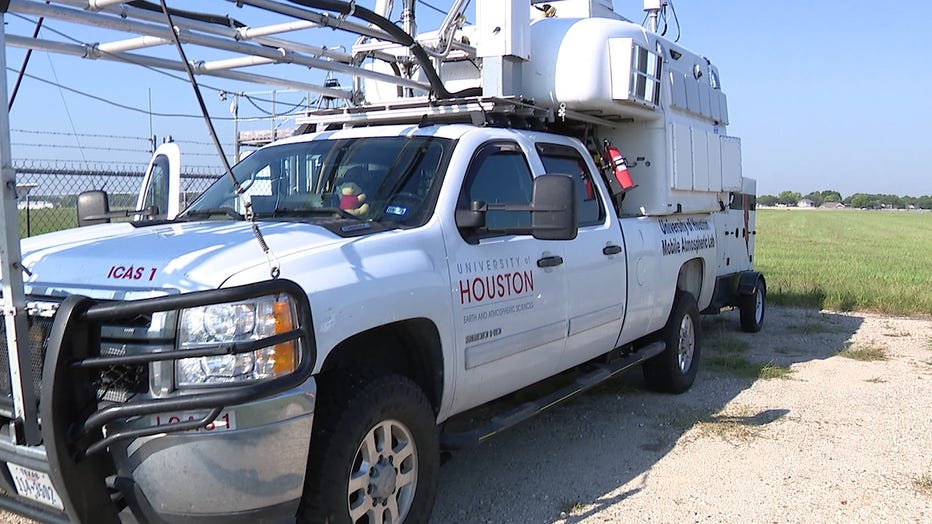TRACER project in Houston helps understand how air quality impacts thunderstorms
TRACER: What role does air quality play in thunderstorm development
Tracer project aims to improve weather forecasting.
HOUSTON - Earlier this year we introduced you to TRACER, a research project taking place here in southeast Texas. The purpose of the project is to better understand the role that air quality plays in how thunderstorms develop.

TRACER looks at the intersection between climate, weather, and pollution to help build a better, cleaner future moving forward.
A study of this scope and magnitude is something Houston has not seen in years. Hundreds of scientists from all over the world have come here to collaborate on this research and they have been deploying everything from trucks, boats, drones, weather balloons - you name it.
"This is going to allow us to evolve the way we think about how ozone formation occurs in the Houston area, and how that ozone then is transported around," said James Flynn, an Associate Professor at the University of Houston about the work being done through the TRACER project.
Travis Griggs, a Ph.D. student at UH works as a Research Assistant to collect data. "The main thing is, we don’t have monitors over water and so there’s some uncertainty of what’s going on over water, especially with respect to air quality," he says.
FULL VIDEO: Tour of TRACER project's mobile air quality lab
This mobile lab has visited various states to perform scientific research! Most recently, it was used in the TRACER Field Campaign to collect data in Houston. FOX 26 Meteorologist Lena Maria Arango and Associate Professor James Flynn from the University of Houston provide an in-depth tour of all of the instruments aboard and their functions.
PREVIOUS STORY: TRACER: Storm formation study takes place in Houston
"When we go to forecast ozone we have computer models that put high ozone over water and so we just don’t know exactly how accurate those are," Griggs adds.
A lot of complex interactions occur where the land meets the sea, so a better understanding of what’s happening in real-time can help improve models and forecasting.
But, other implications extend far beyond weather.
Storm formation study takes place in Houston
EDITORS NOTE: This video is from a previous story. Can air pollution impact thunderstorms? It’s a question that a large group of scientists from all over the world is working to answer right here in Houston.
Subin Yoon is a post-doctoral fellow working under Flynn and manages instruments and the mobile air quality laboratory.
RELATED STORY: Study: Air pollution mostly related to animal farming contributes to 17,900 annual deaths in US
"Definitely one of the first components is like, public health," says Yoon. "We’re being exposed to a lot of these toxins, we’re being exposed to a lot of ozone and so these are bad and contribute to poor health," she adds
The team's mobile air quality laboratory can launch weather balloons, collect air samples, and measure everything from incoming solar radiation to cloud heights.
Air pollution and the pandemic
EDITORS NOTE: This video is from a previous story. At the begninning of the pandemic we saw our air pollution drop thanks to the shut down. But now officials say it's picking back up.
Flynn says, "Similar to how satellites will measure air quality from space looking downward, these are basically using the same techniques from the surface looking upwards."
This allows for a good comparison between satellites and ground observations. Scans occur vertically and horizontally to separate emission types.
"Some of these things are emissions from nature, others come from industrial processes, or vehicles, power plants," Flynn adds.
SUGGESTED STORY: Exclusive: New air pollution sensors installed on Houston's east side
Nevertheless, they all interact and get transported by our weather patterns. This is a game changer, according to Flynn, because now they go to where that weather is happening instead of waiting for the weather to occur.
"What we’re being able to do now is go out and see what’s happening in places we’ve never really been able to look at before," Flynn says. "The work we’re doing on the boats is really new."
Areas that used to not have measurements, have them now, and improving the models with this new information, will improve what the state takes to the Environmental Protection Agency for compliancy.
"What we hope to do is provide the most accurate, scientifically valid information as possible so that the decision-makers who might be working on new policies can make sure that the decisions they’re making is well rooted in science," Flynn explains.
AIR QUALITY: 13 great house plants to improve the air quality in your home, according to science
The more precise the information, the more focused regulations can be on tackling maximizing air quality improvements while also minimizing economic impacts.
"We’re really working to leverage all the measurements that are being made over here at the airport as well as all around the city of Houston, we’re able to utilize their meteorological measurements and match that up with our chemical measurements. And so that’s going to make a really, really powerful dataset that we’re going to be analyzing for a very long time," Flynn said.
The data collection process is ultimately coming to a close, but the work is just beginning with months and months of measurements for years, even decades, to come.
You can check out a behind-the-scenes in-depth tour of the truck and all the instruments on our website.

